How a wisteria borns
|
 Pruning wisteria Pruning wisteria
|
|
|
|
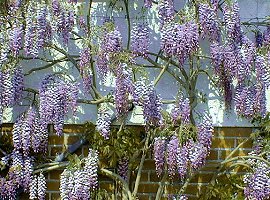 |
|
|
The Wisteria is one of the most rustic, climbing plants ever known to our climate, making it easy to coltivate. However when the plant
is young it needs to be looked after like every other plant.
Soil: Where should it be planted? Of course the most fresh and fertile soil is ideal but the Wisteria is very adaptable therefore able
to thrive well even in dry and stony soils, but not in calcareous or limestone ones. (see disorder - chlorosis)
Planting: Nowadays, we can easily find on the market pot grown Wisterias which can be planted in any season, however in colder climates,
planting is usually advised in spring - Dig a hole in the ground, around 50cm wide and 40cm deep, then mix in the hole well rotten
manure and 200-300g of artificial fertiliser, the best are slow released ones. Make sure the plant pot and the planting ground are well
watered and maintained as such after planting until the rots are grown and the plant is established. Particular attention goes to the
plant pot; often the nursery potting compost is quite dry and if the plant pot is not well watered before planting it will be difficult
for the roots to absorb water even if the surrounding ground is wet.
Fertilising: Continue to apply a balance fertilizer (nitrogen, phosphorus and potassium) once or twice a year until the plant is well
established . Then gradually reduce the quantity of nitrogen until finally eliminate it. Healthy adult plants should only be given a
phosphorous based fertiliser once a year.
Climate and position: The wisteria prefers sun but it will grow in shady positions too where it will flower later and less abundantly.
The wisteria thrives well all around Italy, up to 1000m altitude.
Training and support: Being a climbing plant the wisteria should be guided in a way which allows it to attach and eventually wrap and
wind itself around the chosen support. Begin to shape the plant in the direction and form desired from the first year. Don’t let the
main stems winding into a metal frame, they grow so rapidly and strongly that they could bend the structure: in such a case the plant
should be left to grow straight attaching it (not too tightly) with plastic string or straps to the frame.
The roots: The wisteria roots spread so strongly and abundantly that if planted near walls or pavements they can easily grow into them
causing serious damage . To prevent this from happening it is advised, whilst planting, to insert a corrugated plastic panel which will
force the roots to take other directions, as they are unable to pass through it. Place the plastic panel (at least 2m long) 80cm deep,
between the plant and the wall or pavement (or the surface to be protected). In the case of walls and pavements made with cement this
problem does not exist.
How to choose the correct variety? - Have a clear picture in your mind about the look you would like to achieve for your landscape.
The
first point to bring in to consideration should be the flowering time and the number of flower buds. Think about the atmosphere that you
want to create and how different colours (blue, white or pink) could affect that at that particular time of year. Keep in mind also the
spectacular impact that even the slightest difference in tone can create. In conclusion remember that the wisteria is an overwhelming,
vigorous, centenary plant which will become a very evident and eye-catching part of the landscape which you are creating.
Purchasing a wisteria - The wisteria grows very quickly in its first few years as a result of this it is not necessary to buy a very
large plant, unless the desired effect and shape of a particular plant is needed right away. Many experts advise purchasing the wisteria
in spring after blossoming. This is excellent advice, however it does limit the purchaser in buying and planting the plant in April/May
and exempt the beautiful Japanese variety (Wisteria floribunda) which have a juvenile period of 2 to 4years in which they don’t bare
flowers.
The plant should be always sold with a descriptive label attached, which you can trust. This label usually has a photograph of the plant,
the botanical name and it should also include the common name where it exists. The label should have some descriptive and concise
information about the up keeping of the plant and it should also act as a sufficient assurance and correspondence to other varieties.
See one of our typical labels for the wisteria.
|
 Go to index Go to index |
|
|
Pruning and trimming the wisteria is necessary to maintain an orderly form and to prevent this climbing plant from becoming too
overwhelming and intrusive.
Pruning in summer: Besides giving a much more orderly aspect to the plant, pruning in summer also favours the growth and the
maturity of the flowers buds.
Pruning should be done in the month of July or August and consists in shortening the 1 year old branches up to about 1 metre in
length. If you would like to lengthen the point of the principal branch of the plant , it is possible to leave a suitable branch
without shortening it.
On occasion you will have to cut away and remove the suckers which may have formed at the base of the plant. Leaving them will
make the plant looks messy and being usually grafted they may even come from blow the graft therefore wild.
Pruning in winter: Pruning can begin after leaves fall, although in colder climates it may be better to wait until the end
of winter. All of the branches which are 1 year old should be cut back to 4 to 6 buds. On occasion it will also be necessary to
remove the weak, dry, broken and diseased branches . Again it is also important to remove any tillers which have grown at the
base of the plant. If extension growth is required, leave one of the healthier branches untrimmed and tie it in place so that it can
then grow in the direction and shape wanted.
In this way the plant will achieve a full abundant flowering. In fact the plant will become stronger and the flowering buds will be
bigger and more elegant. The visible trunk of the pruned wisteria adds to its elegance, making it even more ornamental,
especially in old plants.
 Pruning wisteria Pruning wisteria
|
 Go to index Go to index |
|
|
The wisteria is a climbing plant but the possibilities of where and how we can grow it are endless:
|
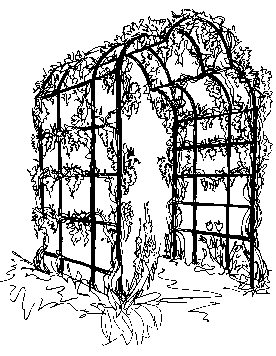 |
PERGOLAS: Probably the most common and classical of styles. A metallic or wooden surface
is needed to support the branches. It is then possible to shape and form the plant in a way which will create a true work of art. Every
adult plant which has been grown on fertile land is capable of covering more than 50 metres squared. If your pergola is made of metal be
careful not to wrap or wind the principle trunk around it as this could result in an undesired bent or folded shape. The most suitable
specie for a pergola is the Wisteria floribunda, it is blessed with having long, clustered, bunches of blossomed branches which dangle
and drape below giving a fantastic effect. |
| PERGOLAS ON THE TERRACE OR BALCONY: With the wisteria we are able to resolve the
problem of having a pergola which covers the second or third floor terrace or balcony of a house. It is necessary to plant the wisteria
next to the nearest wall preferably in fertile ground and allow it to grow until it reaches the desired height and is abundant enough to
cover the pergola. Choose one of the varieties which has a strong growth rate. |
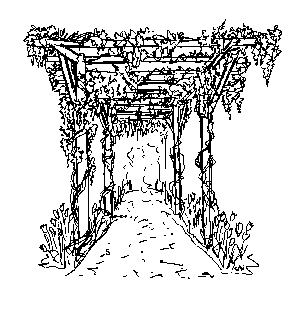 |
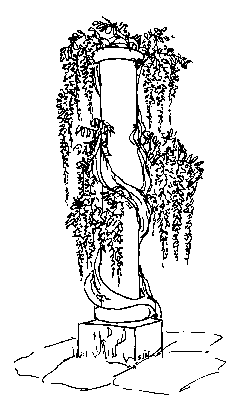 |
PILLARS: The wisteria can be used to cover high poles or posts transforming them into
beautiful pillars. However it is important to keep in mind that if the diameter is larger the 20 cm the plant will need to be guided as
it will be unable to attach and entwine itself . The most suitable species for this training are Wisteria sinensis group and the
Wisteria brachybotrys. |
| WALLS OF A BUILDING: The wisteria can cover an entire wall regardless of size and
height. It is necessary to separate a cluster of branches and place them in iron bulwarks, grouping them together with metal attachments
or tiers. When covering a wall we can be as selective as we want, just like the pergolas. We can choose how much of the wall we want to
cover and in what shape and form we would like to do it, for example, no difficulty or problem exists if only part of a bare wall is
needed to be covered, leaving windows and other architectural parts free. In many antique villas, in Italy you can find these vertical,
green sculptures which blend in perfectly with the architecture of the houses creating a beautiful work of art. The most suitable
varieties for the walls of building are those from the Wisteria sinensis group. |
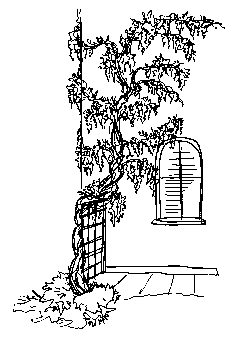 |
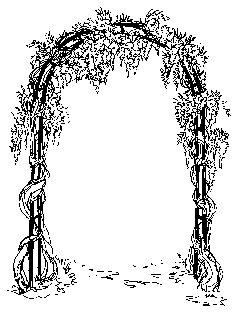 |
BANISTERS, RAILINGS, WALLS AND ARCHES: A thought provoking, eye-catching image is
perceived by leaving the wisteria to grow on the handrail or railing of a balcony or terrace, or on an arch, or even to mark a boundary
between two walls, or to create an edge or border to divide it from surrounding walls. It is important to let the trunk grow straight on
its own until it reaches the desired length. Don't allow it to wrap itself around anything before this point, fix it in place keeping it
straight and still with some bindings. It is also important to keep the branches short. Any variety is suitable, if the length desired
is excessive then choose one of the stronger types. |
ESPALIER: Small or large, isolated or leaning against a wall, it can easily be decorated with a wisteria which has been grown
in a pot or vase. If your espalier is near a garden path, the American wisteria (Wisteria frutescens) is probably the best
choice, which doesn't flower in spring but blooms with its soft foliage and supple branches for a long period of time in June. The most
suitable species are Wisteria sinensis , W. brachybotrys, W.frutescens, or Milletia satsuma.
|
| TREES: An unusual but pretty decorative form. To be grown as one principal, straight
branch , attaching it to a guide until it reaches the desired height, normally about 2m, to form a trunk. A metal pole or tube can
effectively be used as a guide but instead of using only one branch, wind several branches around it. With time the branches will settle
and unite together and incorporate the metal tube giving strength and rigidity to the trunk. The foliage opens and spreads to about 3-4
m. Remember to trim and clean the trunk and in turn shape and form the round foliage. Recommended varieties are any from the Wisteria
floribunda group. |
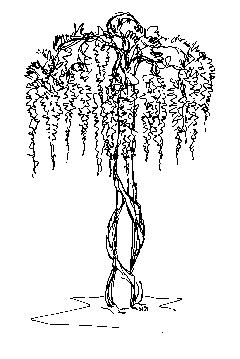 |
CREATING A SOLITARY BUSH FROM THE WISTERIA: If we plant a wisteria , in the middle of some isolated land it will forget that
it is a climbing plant and adaptable as it is, it will form itself into a beautiful garden bush. With regular trimming it will become a
perfectly round shape. Be aware though not to plant other bushes , trees or anything which could be used as a support near it as it will
remember its destiny and begin to climb and twist itself around whatever it is able to. The most recommended varieties are any one of
the Wisteria sinensis, W. brachybotrys and the Milletia satsuma.
ON OTHER TREES: Planting a wisteria next to a large tree is another enchanting idea. The tree will become the guide for the
wisteria and it will be able to wind and wrap itself around the other tree's foliage completely. Guest trees don't usually suffer
excessively, especially if they are trees with thin branches , the end result is a large, healthy looking, beautiful tree with splendid
flowering. A great chromatic effect is gained if the guide tree is one of those which flower in spring, at the same time of the
wisteria, giving a truly fantastic style. Uniting a wisteria and a Cystisus laburnum as guide will give you this effect. They
will both blossom at the same time but the Cystisus laburnum's pure yellow flowers will give a dazzling, eye-catching contrast.
|
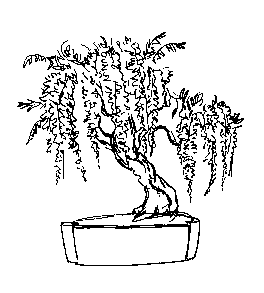 |
BONSAI: It is easy to form a bonsai with almost any plant but the wisteria is
particularly beautiful as one. It is important to trim and prune it regularly because it could easily stray and loose its form. All the
varieties are suitable but in particular the Wisteria brachybotrys and above all the Milletia satsuma. |
 Go to index Go to index |
|
|
The Wisteria is a very rustic and resistant plant, nevertheless, as every living thing, it does have some adversities that can strike
it, for this reason we would like to give a brief description of the principal diseases and the possible remedies:
Black aphid - Plant lice are visible to the naked eye on young sprouting buds especially in spring and in the most humid of seasons,
with the dry, warm seasons this problem will be resolved by itself. Black aphid can only be harmful to very young plants. Only if
necessary and as a last resort should it be treated with proper pesticides.
Red spider mites - This problem could manifest in the warm and dry seasons, it will affect the entire plant above all the adult leaves,
usually giving a dry, singed, appearance. In fact this problem is often mistaken as drought stress. With the help of a magnifying glass
it is possible to see the adult spider mites and their eggs on the lower part of the leaf. When the cooler season arrives this problem
will resolve itself. Only in the case of a very severe attack should this problem be treated with proper pesticides or the specific
biological control (such as predators).
Cryptogam diseases - The leaves could be affected by mildew (Oidium spp.) a fungus that produces a micelius, irregular whitish blotches,
sometimes this problem even attacks the new buds. Cercosporae spp. produces circular marks or blotches on the leaves and black spots
(Phyllosticta spp.) which produce little necrotic marks. Some varieties are more sensitive than others. None of these diseases will
create serious damage and usually it is not necessary to treat them.
Agrobacterium tumefacens – This disease of the root system can cause the death of the plant it can even affect those already well into
their adulthood. No remedy or cure is known for this disease but fortunately it is very rare. The bacteria penetrates through wounds or
cuts, it is good practice to disinfect cuts and tools before and after use.
Wood decay - The wood of old plants can be attacked by a fungus that causes the Prematura death of the plant. Not much can be done
except remove completely the dead wood, cutting back branches up to healthy looking wood, possibly using sterilised tools ( to avoid
ulterior contamination sterilised also after use ) and then paint the surface cut with a fungicide paste: this will help to stop other
infections to penetrate the cut. If this operation is accurately done it will restore itself to normal health.
Chlorosis - This in fact is not a disease but a deficiency: the low content of nutrients in the ground will cause a decolouration of the
leaves (this decolouration can show different tone in respect to the specific nutritive element missing or exciding). This decays in a
lack of chlorophyll therefore a poor photosynthesis and poor develop and growth. An example is a soil with a high content of limestone
prevents the roots from absorbing iron causing a yellow decolouration of the leaves. To resolve this problem distribute 30g-50g per
metre sq. of iron sulphate and 50g-100g per metre sq. of powdered sulphur. Repeat once or twice a year, every year. Sometimes the
problem is due to the presence of some buried debris, in such a case it is necessary to remove the debris.
|
 Go to index Go to index |
|
|
Strangely enough, this question is all a gardener has to answer when talking about wisteria. In fact some plants, even those which
are relatively old, haven't ever blossomed and others have bloomed but with very small, colourless or late flowering. The main reason
for this is probably because the plant has been reproduced or by seed or they have been wrongly pruned.
Plants which have been reproduced with a seed have a long juvenile period (10-15 years) in which there is no flowering.
This type of plants often come from a “black” or dishonest market. In fact reproducing plants in this way is not only easier but it is
also a lot cheaper. A little bit more difficult and much more expensive is propagation throughout grafting or cutting. However by seed
it is only possible to reproduce the common wisteria (Wisteria sinensis).
When buying a wisteria ask the supplier for an ample guarantee.
Some varieties of Wisteria floribunda (the Japanese wisteria) even if reproduced by grafting or cutting have a juvenile period of
2-4 years, during which time there is no flowering (see list of varieties). However these varieties have the most, beautiful,
fluorescent flowering, they are most definitely worth the wait.
Another reason for poor flowering could be the exceeding of nitrogen in the ground: this substance will in fact boost the growth but can
stunt the flowering. The wisteria belongs to the Leguminosae family: all those plants, thanks to the symbiosis with a bacterium that can
fix nitrogen, are able to supply themselves with the quantity needed . Instead use a fertiliser with a phosphorous base will help the
growth and the maturity of the buds.
Finally, when trimmed regularly the wisteria will excel with an abundance of flowers.
|








